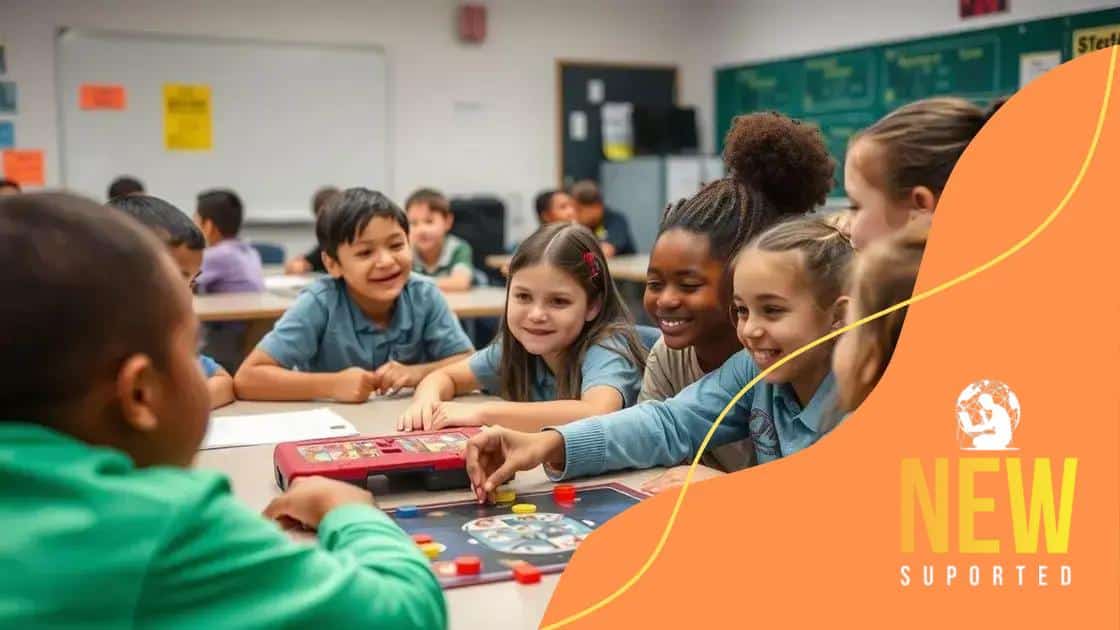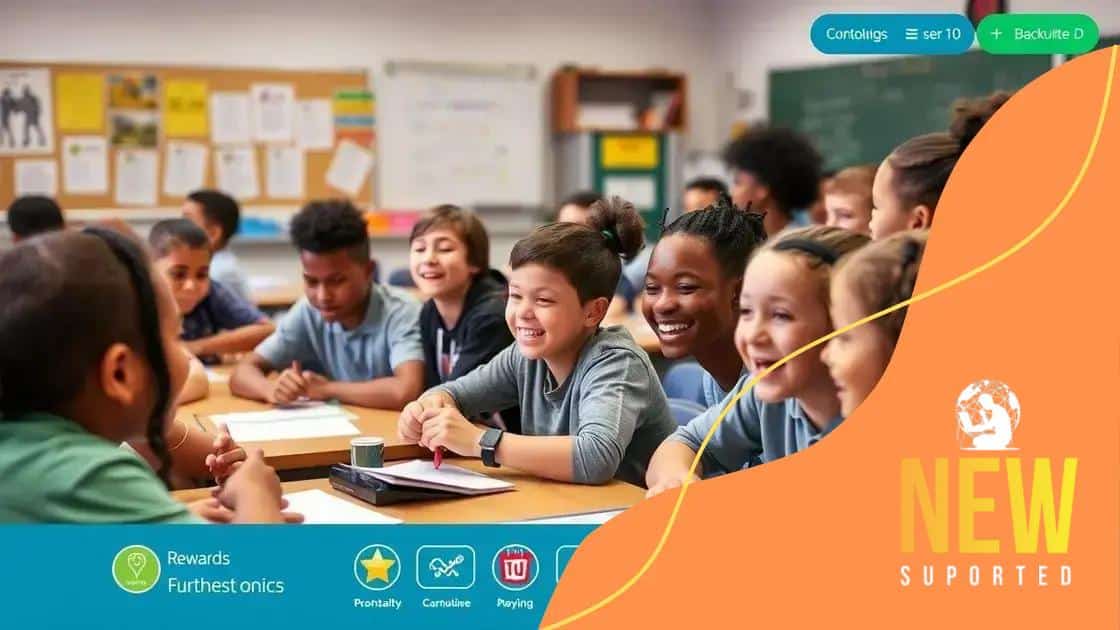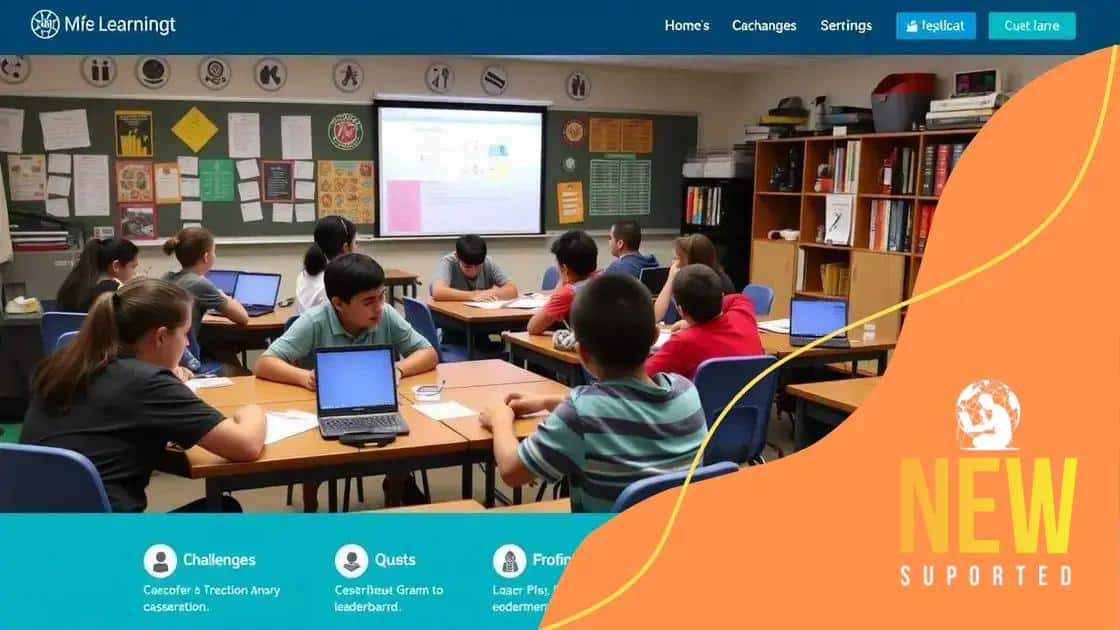How to use gamification for better student engagement

Gamification significantly enhances student engagement by incorporating game-like elements in education, such as rewards and challenges, making learning interactive and motivating.
How to use gamification for better student engagement might sound like a buzzword, but it’s truly about making learning enjoyable. Have you noticed how games captivate attention? By leveraging these elements in education, we can create a more engaging environment for students.
Understanding gamification in education
Understanding gamification in education is crucial for creating interactive and engaging learning experiences. Gamification involves applying game mechanics to non-game contexts to encourage participation and motivation. Have you ever thought about what makes games so engaging? It’s their ability to create a sense of achievement and reward.
What is Gamification?
At its core, gamification applies elements such as points, badges, and challenges to instructional methods. This approach transforms routine learning tasks into exciting challenges that students want to tackle.
Key Components of Gamification
- Points: Students earn points for completing tasks and participating in activities.
- Badges: Visual representations of achievements that motivate students.
- Leaderboards: Encourage friendly competition and track progress.
- Challenges: Specific tasks that involve critical thinking and problem-solving.
Incorporating these components can create an immersive atmosphere. For instance, using a leaderboard can foster a sense of competition, pushing students to strive for better performance. It also makes learning more social, as students often discuss strategies to achieve their goals together.
Another vital aspect of gamification is providing immediate feedback. This helps students understand where they stand in their learning journey and what improvements they can make. Feedback facilitates student engagement by creating a connection between effort and reward.
Furthermore, gamification can promote collaboration among students. By working together to solve challenges or complete tasks, they develop teamwork skills and build relationships. This collaborative spirit enhances the learning experience, making education more enjoyable.
In essence, understanding gamification in education is about recognizing its potential to transform the traditional learning environment. It makes learning not just a requirement but an adventure filled with rewards and achievements.
Benefits of gamification for student engagement

The benefits of gamification for student engagement are significant and can transform how students interact with learning. By incorporating game elements, educators can motivate students in ways that traditional methods often do not.
Increased Motivation
One of the most notable advantages is increased motivation. When students earn points or badges, they become more invested in their learning. This excitement can lead to a deeper commitment to their studies.
Enhanced Learning Experience
Gamification also enhances the learning experience. Instead of viewing homework as a chore, students see challenges as opportunities. This shift in perspective makes learning more appealing and enjoyable.
- Interactive Learning: Students participate actively, leading to better retention of information.
- Immediate Feedback: Players receive real-time updates on their progress, enabling swift adjustments and improvements.
- Skill Development: Gamification encourages critical thinking and problem-solving skills.
Furthermore, gamification can foster a sense of community among students. Working together on tasks or competing in a friendly manner can build relationships and collaboration. This sense of camaraderie makes the classroom environment more inviting.
Additionally, gamification supports diverse learning styles. Students can engage at their own pace and choose how they want to complete tasks. This flexibility allows for personalized learning experiences, which cater to individual needs.
In essence, the benefits of gamification for student engagement are clear. By making learning fun and interactive, educators can create an atmosphere where students not only learn but also thrive.
Key elements of successful gamification
Key elements of successful gamification are essential for creating engaging educational experiences. These elements help motivate students and enhance their learning. Understanding them is crucial for teachers who want to implement gamification effectively.
Clear Objectives
Every gamified activity should start with clear objectives. Students need to know what they are working towards. Setting specific goals helps them focus their efforts and understand the purpose behind their tasks.
Challenges and Rewards
Incorporating meaningful challenges is another key element. Students thrive when faced with tasks that test their skills but are still achievable. When they succeed, recognition through rewards, like points or badges, enhances their sense of accomplishment.
- Variety of Challenges: Include different types of tasks to cater to various skills.
- Instant Feedback: Provide real-time updates on progress to keep students informed.
- Adaptive Difficulty: Adjust challenges based on individual student performance.
Moreover, a balanced competition creates a sense of excitement. Leaderboards can motivate students, encouraging them to improve while fostering friendly rivalry. However, it’s vital to ensure that competition remains healthy and does not overwhelm students.
Additionally, social interaction plays a significant role in impactful gamification. Collaborative tasks encourage teamwork and sharing of ideas. Students often learn from each other while building friendships in the process.
Finally, continuous improvement and iteration matter. Teachers should assess how gamified elements are performing and make necessary adjustments. Gathering feedback from students also helps refine the gamification process, keeping it relevant and effective.
By focusing on these key elements, educators can create a gamification strategy that not only engages students but also enriches their learning journeys.
Practical examples of gamification

Practical examples of gamification in education show how effective this approach can be in engaging students. By using real-world applications, teachers can illustrate important concepts while keeping students enthusiastic about their learning.
Classroom Quests
One practical example is creating classroom quests. Teachers can design challenges where students must complete various tasks to earn rewards. For instance, a science class could transform a unit on ecosystems into a quest where students collect information, complete experiments, and earn badges for each milestone.
Language Learning Apps
Another example is the use of language learning apps that integrate gamification. These applications offer point systems, levels, and quizzes, which motivate students to practice. The more they practice, the higher they climb on the leaderboard, making learning a new language fun and competitive.
- Duolingo: A popular app that uses gamified elements to teach languages through points, levels, and lives.
- Kahoot: An interactive platform that allows teachers to create quizzes where students compete for points in real time.
- Quizlet: Offers flashcards and games that can be used in a competitive way, encouraging collaborative learning.
Additionally, teachers can implement a digital badge system. When a student masters a skill or completes a project, they receive a digital badge. This approach not only encourages achievement but also creates a visual representation of progress.
Gamification can also be applied in team projects. Educators can set up scenarios where students work as teams to solve problems or complete tasks. By assigning roles, leveraging competition, and providing rewards, students are more likely to engage deeply with the material.
These practical examples of gamification in educational settings demonstrate its effectiveness in making learning enjoyable. When students can see their progress and compete in a friendly manner, they are more likely to stay engaged and motivated.
Measuring the impact of gamification
Measuring the impact of gamification is crucial for understanding its effectiveness in enhancing student engagement and learning outcomes. To assess this impact, educators can use various methods that focus on both qualitative and quantitative data.
Student Feedback
One way to measure impact is through student feedback. Surveys and questionnaires can gather insights into how students feel about gamified activities. Questions can cover aspects like motivation, enjoyment, and perceived learning. This feedback is valuable for evaluating which elements of gamification resonate most with students.
Performance Metrics
Performance metrics provide a quantitative approach to gauging success. By analyzing grades, completion rates, and participation levels before and after implementing gamification, teachers can identify trends. For instance, if the number of students completing assignments increases, it may indicate that gamified elements are effective.
- Engagement Rates: Tracking how often students participate in gamified activities helps measure engagement levels over time.
- Achievement Levels: Monitoring the percentage of students achieving specific goals or levels within the gamified system can demonstrate progress.
- Retention Rates: Keeping an eye on how many students continue to participate in gamified activities can indicate the long-term effectiveness.
Additionally, testing and assessment results can further clarify the impact of gamification. Teachers can compare scores from traditional assessments to those following gamified lessons. This analysis can help identify improvements in comprehension and retention of material.
Moreover, educators can observe classroom dynamics. Increased collaboration and communication among students during gamified activities can signal positive engagement. Noticing how students interact can provide insights into the social benefits of gamification.
In conclusion, measuring the impact of gamification involves a combination of student feedback, performance metrics, and observational insights. By using these strategies, teachers can create a clearer picture of how gamification influences learning and adjust their approaches accordingly.
In conclusion, gamification can significantly enhance student engagement and learning outcomes. By incorporating game elements, teachers can create a more interactive and enjoyable educational experience. Understanding and measuring the impact of gamification is essential for continuous improvement. Utilizing student feedback, performance metrics, and classroom observations helps educators refine their approaches. Overall, gamification transforms traditional education into a dynamic and rewarding journey for students.
FAQ – Frequently Asked Questions about Gamification in Education
What is gamification and how does it work in the classroom?
Gamification involves incorporating game elements into learning activities to increase student engagement and motivation. It uses rewards, challenges, and competition to make learning more enjoyable.
How can I measure the effectiveness of gamification in my teaching?
You can measure effectiveness through student feedback, performance metrics, and observing classroom dynamics. Tracking grades, participation rates, and student engagement can help evaluate its impact.
What are some examples of gamification in education?
Examples include classroom quests, educational apps like Duolingo and Kahoot, and implementing a digital badge system to reward student achievements.
How does gamification promote collaboration among students?
Gamification encourages collaborative tasks where students must work together to solve challenges, fostering teamwork and enhancing communication skills.






